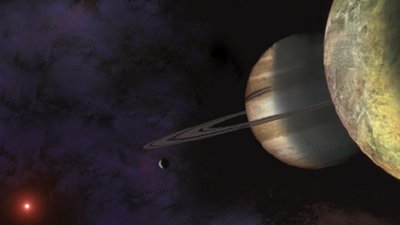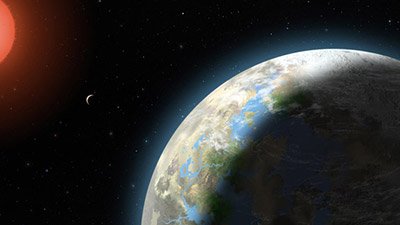Extrasolar Planets
God’s Creative Diversity in Extrasolar Planets
Astronomers have devised some ingenious indirect methods to detect distant planets, known as “extrasolar planets,” or “exoplanets.” Even if the planet cannot be seen directly, we can see its effect on the star. Using this technique (and a few other methods) astronomers have now discovered over 500 extrasolar planets (and counting)!
Kepler Telescope Seeks Out Habitable Planets
NASA launched the Kepler telescope in 2009 to “find terrestrial planets . . . especially those in the habitable zone of their stars where liquid water and possibly life might exist.” But these discoveries do not demonstrate that whatever could randomly happen did happen—cosmologically or biologically.
Are There Extraterrestrials?
The Bible clearly makes man the center of His attention, so we can be sure that no extraterrestrial creatures are made in the image of God, as we are. They would not be the objects of God’s gracious salvation through the death of His uniquely begotten Son, Jesus Christ.
Articles About Extrasolar Planets
-
KIC 8462852: One Strange Little StarMarch 7, 2016
The purpose of the Kepler mission and other searches for extrasolar planets is to find evidence that life is common in the universe.
-
Extrasolar “Super-Earth” Atmosphere Contradicts Evolutionary AssumptionsFeb. 23, 2016
A news story in February 2016 reported the first detection of an atmosphere around a super-earth extrasolar planet, 55 Cancri e.
-
Is Near-Earth-Size Kepler-452b Suitable for Life?Sept. 10, 2015
We here at Answers in Genesis believe that life is unique to Earth, so is the discovery of Kepler-452b a problem for us?
-
Magazine Department ArticleNot So Sure After AllJan. 1, 2015 from Answers Magazine
Everyone has a bias, and everyone makes mistakes.
-
Gliese 581d (2007–2014): RIPOct. 13, 2014
It’s almost comical that a scientist would express “almost no doubt” about life on a non-existent planet.
-
In-Depth ArticleQuest for Goldilocks Planet Scores a Hit with Kepler-186fMay 3, 2014 from Answers in Depth
Kepler Space Telescope pinpoints a potentially habitable earth-sized exoplanet.
-
Jan. 1, 2014 from Answers Magazine
We’re just one out of millions of planets where life is likely to exist. You’ll hear this claim more and more. Don’t believe it.
-
Jan. 1, 2014 from Answers Magazine
New technologies show how special our home really is.
-
-
April 1, 2012 from Answers Magazine
Each new discovery showcases not the possibility of life, but the far-flung wisdom and power of our Creator.
-
Tatooine On RepeatJan. 21, 2012 from News to Know
Kepler: boldly seeking where life could have evolved
-
Kepler’s Mission: To Boldly Seek Out Where Life Could Have EvolvedJan. 20, 2012
Kepler dominates the headlines, and the reason may involve more than just the excitement superlatives generate.
-
NASA Discovers Planet Within a Habitable ZoneDec. 17, 2011 from News to Know
Looking for life in all the right places
-
Magazine Department ArticleFive More Earths?April 1, 2011 from Answers Magazine
The Bible affirms in Genesis 1 that earth is the special place that God chose to fill with living things.
-
Semi-Technical In-Depth ArticleRetrograde Exoplanets Challenge TheoriesFeb. 23, 2011 from Answers in Depth
The following examines some of the new observational methods applied today in studying extrasolar planets and relates recent discoveries to a young age creation viewpoint.
-
Ain't Nobody HomeJan. 29, 2011 from News to Know
-
Scientists Reveal Earth-Sized ExoplanetJan. 15, 2011 from News to Know
Scientists presenting at the winter meeting of the American Astronomical Society have revealed the smallest exoplanet discovered so far.
-
Jan. 1, 2011 from Answers Magazine
If other stars had planets, what would they look like?
-
Dec. 22, 2010 from Answers Magazine
The recent discovery of a unique (so far) planet outside our solar system has caused a lot of excitement and speculation.
-
“Alien Planet” Is an OutsiderNov. 27, 2010
No, the "alien planet" isn't home to alien life (as far as we know); according to astronomers, the planet itself is a veritable outsider in not only its own solar system, but in our entire galaxy.
-
Possible Planet with Life FormsOct. 16, 2010
If true, it would be perhaps the most revolutionary discovery in human history: a planet twenty light-years from earth that is not only habitable, but that has its own life-forms. There’s only one problem: scientists aren’t even sure the planet is there.
-
Astronomical Objects Formed "Recently"June 19, 2010
Two stories this week report on astronomical objects—moons and a planet—that may have formed relatively “recently,” at least in terms of billions-of-years belief.
-
Gaseous Planet May be RockyMarch 20, 2010
A faraway gaseous planet may also be, in a metaphorical sense, “rocky”: astronomers hope it will be a “Rosetta stone” for exoplanetary research.
-
Poor Planet WASP-12bFeb. 27, 2010
Pity poor planet WASP-12b: its host star not only heats it to more than 4,700˚F (2600˚C), but also is in the process of eating it.
-
Kepler Space Telescope Finds First Hot ExoplanetsJan. 9, 2010 from News to Know
Hot, hot, hot, hot, and hot—meet the first exoplanets found by NASA’s Kepler space telescope.
-
Super-Earths?Dec. 19, 2009 from News to Know
Astronomers may soon find more “Earth-like” planets—and with them, alien life?
-
Planets Likely to Have Life NamedOct. 17, 2009 from News to Know
It’s the “Standard Microbial Habitability index,” an attempt to quantitatively define a planetary body’s suitability for life.
-
The Demise of Planet WASP-18bAug. 29, 2009 from News to Know
A recently discovered exoplanet may have been found just in the nick of time—in time for us to witness its demise, that is.
-
Goofy Planet is BackwardsAug. 15, 2009 from News to Know
For the first time, astronomers have detected a planet that could be said to “swim against the flow”—orbiting in the opposite direction from the spin of its star.
-
Leaning Tower of Planet FormationJune 20, 2009 from News to Know
A planet with a “steeply tilted” orbit—will it help refine theories of planetary formation or reveal their flaws?
-
The Earth That Wasn'tApril 25, 2009 from News to Know
Astronomers have found another “Earthlike” planet outside of our solar system.
-
How Many Earths Again?Feb. 21, 2009 from News to Know
Two weeks ago we covered a study that said there could be up to 37,964 alien civilizations in the Milky Way. Now, the number of Earth-like planets in the Milky Way has been enumerated: 100,000,000,000.
-
Home Away from HomeFeb. 7, 2009 from News to Know
Astronomers have found yet another “Earth-like” planet (how many does this make, anyway?). Once again, it’s not exactly home away from home.
-
Seeds of Life Found on most Planets Upon FormationDec. 6, 2008
Are the seeds of life commonly planted when a planet is formed?
-
Extrasolar Planet Now Hottest Ever DiscoveredOct. 25, 2008
If Earth’s neighbor Venus—known for high pressure, high temperatures, and toxic gases—sounds unwelcoming, wait till you learn about planet WASP-12b.
-
Magazine Department ArticleThe Youngest Planet?Oct. 1, 2008 from Answers Magazine
Astronomers have discovered signs of a planet outside our solar system which may be less than two thousand years old.
-
Minor Planet Helps Answer Comet ConundrumAug. 23, 2008
It may not have an impressive name, but minor planet 2006 SQ372 has a big role to play. Could this be the answer to the old-age comet conundrum?
-
Astronomers On the Verge of Finding Extrasolar Planets like EarthJune 28, 2008
Sooner or later, say some astronomers, we’ll run across an extrasolar planet so similar to our own planet that we’ll be able to call it “Earth’s twin.”
-
Astronomers Discover Three “Super Earths”June 21, 2008
None of them have been named Krypton, but astronomers have identified three “Super-Earths” in a star system 42 light-years from Earth.
-
Extrasolar Planets Give Hope For Those Who Believe in ExtraterrestrialsJune 7, 2008
The finding of the smallest known extrasolar planet yet is giving hope to those who already believe aliens are out there.
-
Livable Planets Believed to Be More CommonFeb. 23, 2008
The search for life far from earth seems to expand every month, with greater attention—and money—focused on finding planets with “conditions suitable for life.” Now, a new study suggests these “livable” planets may be more common than we thought.
-
Magazine Department ArticleUnseen PlanetOct. 1, 2007 from Answers Magazine
When a planet bears any resemblance to our own planet, the speculation begins that it may be the home to extraterrestrial life.
-
Possible Water Vapor Tantalizes AstronomersJuly 14, 2007 from News to Know
The exoplanetary-analysis community is buzzing with news this week of the possible discovery of water on HD189733b, an exoplanet 64 light-years from earth.
-
Search for Spock: New MissionMay 12, 2007
Scientists at NASA’s Jet Propulsion Laboratory are eagerly considering the prospect of life on an earth-like planet (named Vulcan in homage to Star Trek) orbiting a nearby star.
-
Earth #2April 28, 2007
Scientists are exuberant following the discovery of a planet only slightly larger than earth.

Answers in Genesis is an apologetics ministry, dedicated to helping Christians defend their faith and proclaim the good news of Jesus Christ.
- Customer Service 800.778.3390
- Available Monday–Friday | 9 AM–5 PM ET
- © 2026 Answers in Genesis









